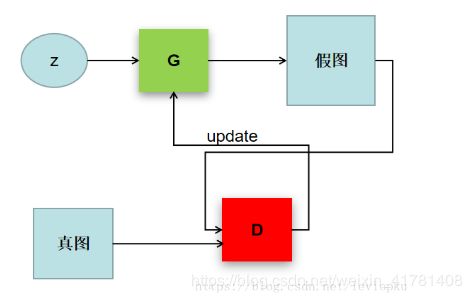莫烦pytorch学习笔记6
莫烦pytorch学习笔记6
- 1.生成对抗网路gan
- 1.1 介绍
- 1.2GAN的原理
- 1.3 L1正则化和L2正则化实现
1.生成对抗网路gan
1.1 介绍
生成式对抗网络(GAN, Generative Adversarial Networks )是一种深度学习模型,是近年来复杂分布上无监督学习最具前景的方法之一。模型通过框架中(至少)两个模块:生成模型(Generative Model)和判别模型(Discriminative Model)的互相博弈学习产生相当好的输出。原始 GAN 理论中,并不要求 G 和 D 都是神经网络,只需要是能拟合相应生成和判别的函数即可。但实用中一般均使用深度神经网络作为 G 和 D 。一个优秀的GAN应用需要有良好的训练方法,否则可能由于神经网络模型的自由性而导致输出不理想。
1.2GAN的原理
这里介绍的是原生的GAN算法,虽然有一些不足,但提供了一种生成对抗性的新思路。
理解GAN的两大护法G和D
G是generator,生成器: 负责凭空捏造数据出来
D是discriminator,判别器: 负责判断数据是不是真数据
这样可以简单的看作是两个网络的博弈过程。在最原始的GAN论文里面,G和D都是两个多层感知机网络。首先,注意一点,GAN操作的数据不一定非得是图像数据,不过为了更方便解释,我在这里用图像数据为例解释以下GAN:
import torch
import torch.nn as nn
from torch.autograd import Variable
import numpy as np
import matplotlib.pyplot as plt
torch.manual_seed(1) # reproducible
np.random.seed(1)
# Hyper Parameters
BATCH_SIZE = 64
LR_G = 0.0001 # learning rate for generator
LR_D = 0.0001 # learning rate for discriminator
N_IDEAS = 5 # think of this as number of ideas for generating an art work (Generator)
ART_COMPONENTS = 15 # it could be total point G can draw in the canvas
PAINT_POINTS = np.vstack([np.linspace(-1, 1, ART_COMPONENTS) for _ in range(BATCH_SIZE)])
# print(PAINT_POINTS)
# show our beautiful painting range
plt.plot(PAINT_POINTS[0], 2 * np.power(PAINT_POINTS[0], 2) + 1, c='#74BCFF', lw=3, label='upper bound')
plt.plot(PAINT_POINTS[0], 1 * np.power(PAINT_POINTS[0], 2) + 0, c='#FF9359', lw=3, label='lower bound')
plt.legend(loc='upper right')
plt.show()
def artist_works(): # painting from the famous artist (real target)
a = np.random.uniform(1, 2, size=BATCH_SIZE)[:, np.newaxis]
paintings = a * np.power(PAINT_POINTS, 2) + (a-1)
paintings = torch.from_numpy(paintings).float()
return Variable(paintings)
G = nn.Sequential( # Generator
nn.Linear(N_IDEAS, 128), # random ideas (could from normal distribution)
nn.ReLU(),
nn.Linear(128, ART_COMPONENTS), # making a painting from these random ideas
)
D = nn.Sequential( # Discriminator
nn.Linear(ART_COMPONENTS, 128), # receive art work either from the famous artist or a newbie like G
nn.ReLU(),
nn.Linear(128, 1),
nn.Sigmoid(), # tell the probability that the art work is made by artist
)
opt_D = torch.optim.Adam(D.parameters(), lr=LR_D)
opt_G = torch.optim.Adam(G.parameters(), lr=LR_G)
for step in range(10000):
artist_paintings = artist_works() # real painting from artist
G_ideas = Variable(torch.randn(BATCH_SIZE, N_IDEAS)) # random ideas
G_paintings = G(G_ideas) # fake painting from G (random ideas)
prob_artist0 = D(artist_paintings) # D try to increase this prob
prob_artist1 = D(G_paintings) # D try to reduce this prob
D_loss = - torch.mean(torch.log(prob_artist0) + torch.log(1. - prob_artist1))
G_loss = torch.mean(torch.log(1. - prob_artist1))
opt_D.zero_grad()
D_loss.backward(retain_graph=True) # retain_variables for reusing computational graph
opt_D.step()
opt_G.zero_grad()
G_loss.backward()
opt_G.step()
if step % 1000 == 0: # plotting
plt.cla()
plt.plot(PAINT_POINTS[0], G_paintings.data.numpy()[0], c='#4AD631', lw=3, label='Generated painting',)
plt.plot(PAINT_POINTS[0], 2 * np.power(PAINT_POINTS[0], 2) + 1, c='#74BCFF', lw=3, label='upper bound')
plt.plot(PAINT_POINTS[0], 1 * np.power(PAINT_POINTS[0], 2) + 0, c='#FF9359', lw=3, label='lower bound')
plt.text(-.5, 2.3, 'D accuracy=%.2f (0.5 for D to converge)' % prob_artist0.data.numpy().mean(), fontdict={'size': 15})
plt.text(-.5, 2, 'D score= %.2f (-1.38 for G to converge)' % -D_loss.data.numpy(), fontdict={'size': 15})
plt.ylim((0, 3));plt.legend(loc='upper right', fontsize=12);plt.draw();plt.pause(0.01)
plt.show()
1.3 L1正则化和L2正则化实现
class MLP(torch.nn.Module):
def __init__(self):
super(MLP,self).__init__()
self.linear1 = torch.nn.Linear(128,32)
self.linear2 = torch.nn.Linear(32,16)
self.linear3 = torch.nn.Linear(16,2)
def forward(self,x):
out1 = F.relu(self.linear1(x))
out2 = F.relu(self.linear2(out1))
out = F.relu(self.linear3(out2))
return out,out1,out2
def l1_penalty(var):
return torch.abs(var).sum()
def l2_penalty(var):
return torch.sqrt(torch.pow(var,2).sum())
batchsize = 4
lambda1,lambda2 = 0.5,0.01
for i in range(1000):
model = MLP()
optimizer = torch.optim.SGD(model.parameters(),lr =1e-4)
inputs = torch.rand(batchsize,128)
targets = torch.ones(batchsize).long()
optimizer.zero_grad()
outputs,out1,out2 = model(inputs)
cross_entropy_loss = F.cross_entropy(outputs,targets)
l1_regularization = lambda1 * l1_penalty(out1)
l2_regularization = lambda2 * l2_penalty(out2)
loss = cross_entropy_loss + l1_regularization + l2_regularization
print(i,loss.item())
loss.backward()
optimizer.step()
参考:
https://blog.csdn.net/Heitao5200/article/details/90404177
https://blog.csdn.net/leviopku/article/details/81292192

